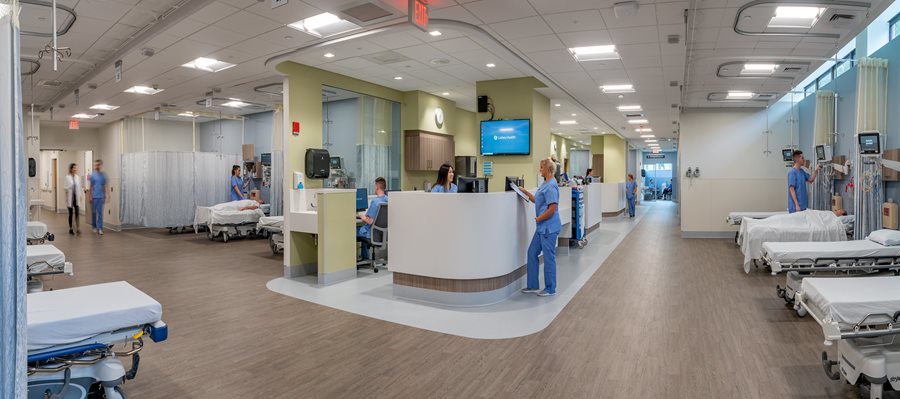
Hospitals and healthcare facilities are bustling hubs of activity where time is of the essence. With machines in constant operation and healthcare professionals making quick decisions, noise becomes an intrinsic part of the environment. While noise itself is not inherently damaging, prolonged exposure to high noise levels can significantly affect both patient recovery and the wellbeing of healthcare staff. Let's explore the impact of noise in healthcare settings and how to minimise its effect.
Understanding the sources of noise
Noise in healthcare environments comes from two primary sources: internal factors within the building and design-related issues. Internal factors include noise generated by electrical items commonly found in healthcare settings. Think alarms, monitors, and diagnostic equipment. Communication systems like announcement speakers and ringing phones also contribute to the overall sound levels. And, of course, conversations and speech also add to the mix.
The design of healthcare facilities also contributes to noise levels. Many environments use hard, smooth surfaces like walls, floors, and ceilings for easy cleaning and hygiene maintenance. However, this design choice and the layout of the space can create problems. When sound hits these hard surfaces, it bounces off and travels down corridors, reaching patient rooms far from the original noise source. The abundance of hard surfaces also leads to echo and reverberation, distorting and muffling speech. As a result, people, including staff, patients, and visitors, need to speak louder to be heard clearly.
How noise affects patient recovery
When patients are admitted to a healthcare facility, their primary focus is healing and recovery. A quiet, calm environment can significantly enhance patient comfort and help promote rest and recovery. However, excessive noise levels can impede this process. Studies show that prolonged exposure to high noise levels can increase stress and anxiety among patients and disrupt their sleep patterns.
The impact of noise on staff wellbeing
While patients are the primary concern, it's essential not to overlook the wellbeing of the healthcare professionals working tirelessly to provide optimal care. Day in and out, staff are exposed to high noise levels. Persistent noise can lead to fatigue, decreased concentration, and heightened stress levels, ultimately affecting their overall job performance and job satisfaction. Managing noise levels is crucial for preserving the physical and mental wellbeing of the healthcare workforce.
Managing noise in healthcare environments
Creating an environment that balances functionality and patient wellbeing requires a proactive approach to noise management. Here are a few strategies healthcare facilities can employ:
-
Incorporating effective noise controls
Design-based solutions can tackle excessive noise by incorporating noise controls into the building. Investing in noise reduction measures such as sound-absorbing materials, including acoustic flooring, wall panels and installing acoustic insulation directly into wall or ceiling cavities can significantly minimise the impact of noise within healthcare spaces.
-
Optimising equipment placement for noise reduction
When planning the layout of machinery and equipment in a healthcare facility, it is important to minimise the distance that noise travels. Where appropriate and safe, isolating noisy equipment and locating them away from patient areas can help mitigate the impact of noise on patient comfort.
-
Promote a quiet environment
It is important to emphasise the importance of maintaining a quiet environment and implementing noise reduction practices for all users of healthcare spaces. Encouraging practices like speaking softly, closing doors gently, and turning off unnecessary alarms can create a quieter atmosphere.
-
Technology solutions
Advancements in technology offer innovative solutions to address noise-related challenges. For instance, integrating quiet operation modes in equipment or utilising noise-cancelling headphones for staff members can help reduce noise exposure.
In the fast-paced world of hospitals and healthcare facilities, noise is inevitable. However, recognising the potential negative consequences of prolonged exposure to high noise levels is crucial. Healthcare facilities can create an environment that promotes patient recovery and staff wellbeing by prioritising noise management strategies. Striking a balance between efficiency and quiet will undoubtedly contribute to the overall quality of care, ensuring a healing environment for all.
Discover Altro’s acoustics solutions


 Hospitals and healthcare facilities are bustling hubs of activity where time is of the essence. With machines in constant operation and healthcare professionals making quick decisions, noise becomes an intrinsic part of the environment. While noise itself is not inherently damaging, prolonged exposure to high noise levels can significantly affect both patient recovery and the wellbeing of healthcare staff. Let's explore the impact of noise in healthcare settings and how to minimise its effect.
Hospitals and healthcare facilities are bustling hubs of activity where time is of the essence. With machines in constant operation and healthcare professionals making quick decisions, noise becomes an intrinsic part of the environment. While noise itself is not inherently damaging, prolonged exposure to high noise levels can significantly affect both patient recovery and the wellbeing of healthcare staff. Let's explore the impact of noise in healthcare settings and how to minimise its effect.
